Description  The cardinal is about eight inches in length. It has a black mask on its face; a crest on its head; and a short, cone-shaped bill. The mask on the female is usually lighter than the mask on the male. The cardinal is about eight inches in length. It has a black mask on its face; a crest on its head; and a short, cone-shaped bill. The mask on the female is usually lighter than the mask on the male.
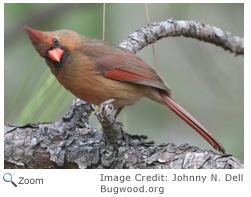 Cardinals are known for their bright red color, but only the male is red. The female is a dull brown or olive color with dull red on her wings and tail. Cardinals are known for their bright red color, but only the male is red. The female is a dull brown or olive color with dull red on her wings and tail.
Range 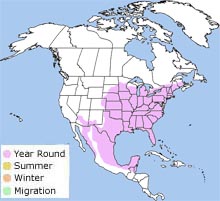 The northern cardinal is found in most parts of United States east of the Rocky Mountains. It is also found in parts of Arizona, California, and New Mexico. The range of the cardinal has increased in the last 50 years to include New York and New England. It is now found throughout New Hampshire. Changes in habitats caused by humans have made more areas available to the cardinal and made it easier for it to find the food it needs to survive in colder climates. The northern cardinal is found in most parts of United States east of the Rocky Mountains. It is also found in parts of Arizona, California, and New Mexico. The range of the cardinal has increased in the last 50 years to include New York and New England. It is now found throughout New Hampshire. Changes in habitats caused by humans have made more areas available to the cardinal and made it easier for it to find the food it needs to survive in colder climates.
Habitat
 Cardinals tend to live at the edge of woodlands and in the vegetation near houses and gardens. The male cardinal aggressively defends its territory. In fact, a male cardinal may even defend its territory from a reflection of itself in a window or a mirror! Cardinals tend to live at the edge of woodlands and in the vegetation near houses and gardens. The male cardinal aggressively defends its territory. In fact, a male cardinal may even defend its territory from a reflection of itself in a window or a mirror! |
|
Diet
Cardinals eat seeds, grains, fruits, and insects. They can often be found at bird feeders!
Life Cycle
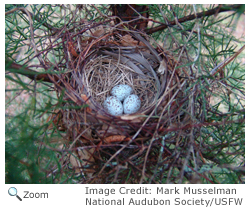 Cardinals usually raise two broods of young a year. They mate in March and again from May to July. The female usually lays four eggs. The eggs take about 12 days to hatch. Cardinals usually build cup-shaped nests in small trees, bushes, shrubs, and thick vines that are no more than three to eight feet off the ground. Their nests are made of twigs and bark and are lined with grass, moss, and other soft materials. Young cardinals fledge when they are 11-13 days old. Cardinals usually raise two broods of young a year. They mate in March and again from May to July. The female usually lays four eggs. The eggs take about 12 days to hatch. Cardinals usually build cup-shaped nests in small trees, bushes, shrubs, and thick vines that are no more than three to eight feet off the ground. Their nests are made of twigs and bark and are lined with grass, moss, and other soft materials. Young cardinals fledge when they are 11-13 days old.
Behavior
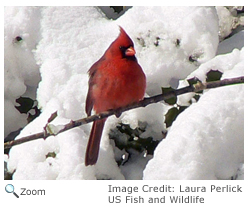 Cardinals are non-migratory birds. Most cardinals live within a mile of where they were born. Cardinals are song birds, and the male uses its call to attract a mate. Cardinals are non-migratory birds. Most cardinals live within a mile of where they were born. Cardinals are song birds, and the male uses its call to attract a mate.
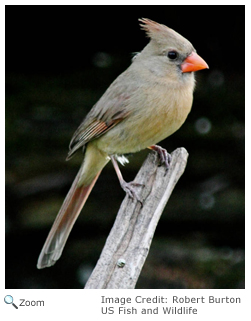 Unlike most northern songbirds, the female also sings. Females often sing from the nest in what may be a call to her mate. Cardinal pairs have song phrases that they share. If you listen carefully, on the first sunny days of late winter, you may hear the cardinal's song. It sounds like 'cheer, cheer, cheer' or a short 'chink' sound. Unlike most northern songbirds, the female also sings. Females often sing from the nest in what may be a call to her mate. Cardinal pairs have song phrases that they share. If you listen carefully, on the first sunny days of late winter, you may hear the cardinal's song. It sounds like 'cheer, cheer, cheer' or a short 'chink' sound.
|

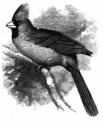


 The northern cardinal is found in most parts of United States east of the Rocky Mountains. It is also found in parts of Arizona, California, and New Mexico. The range of the cardinal has increased in the last 50 years to include New York and New England. It is now found throughout New Hampshire. Changes in habitats caused by humans have made more areas available to the cardinal and made it easier for it to find the food it needs to survive in colder climates.
The northern cardinal is found in most parts of United States east of the Rocky Mountains. It is also found in parts of Arizona, California, and New Mexico. The range of the cardinal has increased in the last 50 years to include New York and New England. It is now found throughout New Hampshire. Changes in habitats caused by humans have made more areas available to the cardinal and made it easier for it to find the food it needs to survive in colder climates. 


